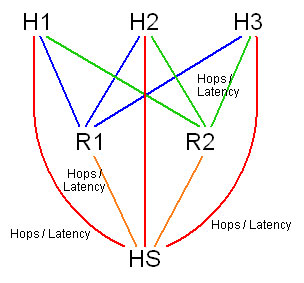This problem requires you to run a traceroute from your computer to some hosts and count number of hops required to reach the destination and also record the latency to reach the destination. You can run "traceroute using any of the following ways.
- from textbook companion website,
- run "tracert" on your Windows 95/98/NT/2000 machines, or
- if you have an account on bayou, you can run "traceroute" at prompt or /usr/sbin/traceroute if it can't be found. Here is the man page of traceroute. It contains detail info about the command line parameters and the format of output.
- There is a web site called www.traceroute.org. This site provides links to hosts all over the world which provide interfaces to run traceroute from their local machines or routers. So you can run traceroute from Finland (EUNet) or Italy (IHnet).
- There is an interesting shareware called VisualRoute which shows the traceroute path on a world map. It's very cool. And you can also try their live demo on 7 VisualRoute servers around the world (using JAVA as interface).
Here is what you need to do. First of all, pick three (3) of the following hosts and label them as H1, H2, and H3.
- www.utexas.edu - University of Texas at Austin, Austin, Texas, U.S.A.
- www.lucent.com - Lucent Technologies, Inc., ??, U.S.A.
- www.cam.ac.uk - University of Cambridge, Cambridge, UK
- www.unisa.ac.za - University of South Africa, Pretoria, South Africa
- www.otago.ac.nz - University of Otago, Dunedin, New Zealand
- www.uba.ar - Universidad de Buenos Aires, Buenos Aires, Argentina
Secondly, pick two hosts as routers from www.traceroute.org and label them as R1 and R2. Also, record their host names.
Thirdly, run traceroute from source (R1 and R2) to destination (H1, H2, and H3). Record number of hops and latency between source and destination. You should have 6 values for number of hops and 6 values for latency.
Fourthly, pick a home site. You can use your own PC (running Linux/BSD/Windows 95/98/NT/2000), bayou, or any host from www.traceroute.org (other than R1 and R2). We will label it as HS. Record host name or IP address of HS.
Fifthly, run traceroute from source (HS) to destination (R1, R2, H1, H2, and H3). Record number of hops and smallest latency between source and destination. You should have 5 values for number of hops and 5 values for latency.
Now draw a graph similar to this one. Replace H1, H2, H3, R1, R2, and HS with their host names or IP addresses. Label each link with number of hops and latency.
Finally, calculate the total number of hops and latency between home site (HS) and hosts (H1, H2, and H3). Also, calculate the total number of hops and latency from home site (HS) via routers (R1 or R2) to hosts (H1, H2, and H3). You will have a table like this.
| Paths |
# of hops
|
Latency (msec)
|
| HS-H1 + HS-H2 + HS-H3 | ||
| HS-R1-H1 + HS-R1-H2 + HS-R1-H3 | ||
| HS-R2-H1 + HS-R2-H2 + HS-R2-H3 |
Questions you might have:
- Question: When calculating latency time from host to destination, which values do we use in the traceroute result? Each hop has 3 time fields listed after it. I'm not sure which to use.
Answer: Traceroute lunches 3 probes (by default). Just pick the smallest one.- Question: What number in the output of traceroute should we use as the latency?
Answer: Here is an example (traceroute to HBU - Houston Baptist University).
Bayou.UH.EDU> traceroute www.hbu.edu traceroute to www.hbu.edu (206.97.180.13), 30 hops max, 40 byte packets 1 caesar-atm12-00-1.gw.uh.edu (129.7.1.251) 1 ms 2 ms 0 ms 2 a1-3-1-0-3.a01.hstntx01.us.ra.verio.net (128.241.2.33) 2 ms 2 ms 2 ms 3 ge-0-1-0.r00.hstntx01.us.bb.verio.net (129.250.30.209) 2 ms 2 ms 2 ms 4 p4-4-0-0.r01.dllstx01.us.bb.verio.net (129.250.3.193) 7 ms 7 ms 7 ms 5 p4-2-0.r00.dllstx01.us.bb.verio.net (129.250.3.73) 7 ms 7 ms 8 ms 6 core4-serial0-0-0-0.Dallas.cw.net (204.70.10.77) 8 ms 9 ms 8 ms 7 corerouter2.Dallas.cw.net (204.70.9.150) 20 ms 10 ms 12 ms 8 acr2-loopback.Dallasdan.cw.net (208.172.130.62) 9 ms 10 ms 9 ms 9 aar1-loopback.Dallasdan.cw.net (208.172.130.2) 10 ms 10 ms 9 ms 10 internet-access-point-corp.Dallasdan.cw.net (208.172.135.18) 15 ms 16 ms 15 ms 11 gateway-005.Houston.iapc.net (204.71.92.23) 17 ms 22 ms 18 ms 12 206.97.180.1 (206.97.180.1) 22 ms 21 ms 20 ms 13 206.97.180.13 (206.97.180.13) 23 ms 22 ms 22 msThere are 3 numbers (23ms, 22ms, 22ms) in very last line (No. 13). They are round-trip time to the destination. So you should pick the shortest time and divide it by 2. In this case, the latency between bayou.uh.edu to www.hbu.edu is 11ms.
One interesting observation is that the route from UH to HBU actually goes through Dallas and come back to Houston, although HBU is located in the southwestern side of Houston.
